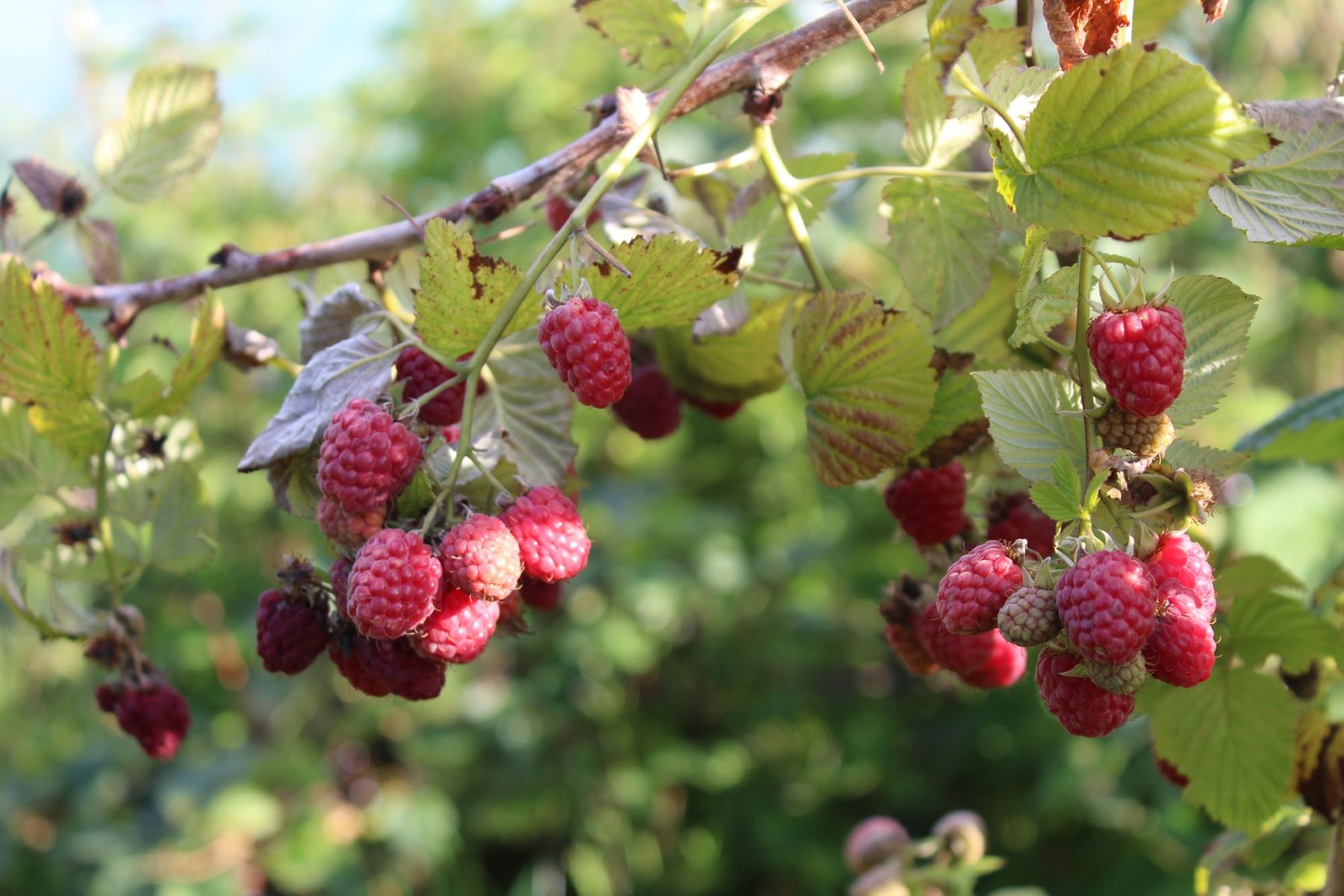Home>Food and Cooking>The Ultimate Guide To Maximizing The Health Of Your Patio Tomato Plants!


Food and Cooking
The Ultimate Guide To Maximizing The Health Of Your Patio Tomato Plants!
Modified: February 28, 2024
Discover expert tips and tricks for growing healthy patio tomato plants in this ultimate guide. From soil preparation to watering and fertilizing, elevate your food and cooking experience with thriving homegrown produce!
(Many of the links in this article redirect to a specific reviewed product. Your purchase of these products through affiliate links helps to generate commission for Regretless.com, at no extra cost. Learn more)
Table of Contents
- Introduction
- Choosing the Right Tomato Varieties for Your Patio
- Selecting the Best Location for Your Patio Tomato Plants
- Preparing the Soil for Planting
- Planting Your Patio Tomato Plants
- Watering and Fertilizing Your Patio Tomato Plants
- Pruning and Supporting Your Patio Tomato Plants
- Managing Pests and Diseases
- Harvesting and Enjoying Your Patio Tomato Plants
- Conclusion
Introduction
Welcome to the ultimate guide to maximizing the health of your patio tomato plants! Whether you're a seasoned gardener or a novice with a green thumb, this comprehensive guide will equip you with the knowledge and techniques needed to cultivate thriving tomato plants right on your patio.
Tomatoes are a popular choice for home gardeners due to their versatility, vibrant flavors, and numerous culinary applications. With the right care and attention, patio tomato plants can yield bountiful harvests of juicy, sun-ripened tomatoes that are bursting with flavor. By following the tips and strategies outlined in this guide, you'll be well on your way to growing robust and healthy tomato plants that will reward you with a plentiful supply of delicious tomatoes throughout the growing season.
From selecting the ideal tomato varieties for your patio space to mastering the art of watering, fertilizing, and protecting your plants from pests and diseases, each aspect of tomato plant care will be explored in detail. You'll learn how to create the optimal growing environment for your patio tomato plants and discover the best practices for ensuring their longevity and productivity.
Whether you're limited on outdoor space or simply prefer the convenience of container gardening, patio tomato plants offer a fantastic opportunity to cultivate fresh, homegrown produce right outside your door. With the right guidance and a passion for gardening, you can transform your patio into a thriving tomato garden that not only enhances the aesthetic appeal of your outdoor living space but also provides you with a plentiful supply of flavorful, vine-ripened tomatoes.
So, roll up your sleeves, grab your gardening gloves, and get ready to embark on an exciting journey of nurturing and cultivating patio tomato plants that will yield a rich and rewarding harvest. Let's dive into the world of patio tomato gardening and uncover the secrets to growing healthy, robust, and delicious tomatoes right on your own patio!
Choosing the Right Tomato Varieties for Your Patio
When it comes to growing tomatoes on your patio, selecting the right tomato varieties is crucial for a successful harvest. With a wide array of tomato cultivars available, it's essential to choose varieties that are well-suited for container gardening and patio spaces. Here are some key factors to consider when selecting the perfect tomato varieties for your patio:
Determinate vs. Indeterminate Varieties
Determinate tomato varieties, also known as bush tomatoes, are compact and typically well-suited for container gardening. These varieties tend to grow to a predetermined height and produce fruit within a relatively condensed timeframe, making them ideal for patio gardens with limited space. On the other hand, indeterminate tomato varieties are vining plants that continue to grow and produce fruit throughout the growing season. While indeterminate varieties may require staking or support, they can also thrive in large containers on patios, provided they have ample room to grow.
Compact Growth Habit
When choosing tomato varieties for your patio, opt for compact or dwarf cultivars that are specifically bred for container gardening. Compact tomato plants are well-suited for small spaces and can thrive in pots or containers, making them an excellent choice for patio gardens. Look for varieties labeled as "patio," "dwarf," or "bush" tomatoes, as these are tailored to flourish in confined growing environments.
Fruit Size and Yield
Consider the size and yield of the tomato varieties you select. Patio tomato plants often thrive when they produce smaller to medium-sized fruits, as these varieties tend to mature more quickly and are well-suited for container growth. Cherry and grape tomato varieties are popular choices for patio gardening, as they offer abundant yields of bite-sized, flavorful tomatoes that are perfect for snacking and culinary use.
Disease Resistance
When choosing tomato varieties for your patio, prioritize cultivars with resistance to common tomato diseases. Look for varieties that are bred to withstand common issues such as blight, wilt, and other fungal diseases. Disease-resistant tomato plants are more likely to thrive in container environments and are less susceptible to succumbing to common ailments that can affect tomato plants.
By carefully selecting the right tomato varieties for your patio, you can set the stage for a successful and rewarding growing experience. Whether you opt for compact determinate varieties or choose to cultivate vining indeterminate plants, there are numerous tomato cultivars tailored to thrive in container gardens and patio spaces. With the proper selection of tomato varieties, you can look forward to a bountiful harvest of fresh, flavorful tomatoes right on your own patio.
Selecting the Best Location for Your Patio Tomato Plants
The success of your patio tomato plants hinges on choosing the optimal location for their growth. When it comes to cultivating thriving tomato plants on your patio, the right placement can make a significant difference in their overall health and productivity. Here's a detailed exploration of the key factors to consider when selecting the best location for your patio tomato plants:
Sunlight Exposure
Tomato plants thrive in ample sunlight, so it's crucial to choose a location on your patio that receives at least 6-8 hours of direct sunlight per day. South-facing or west-facing areas are often ideal for maximizing sun exposure, as they receive the most sunlight throughout the day. When scouting for the perfect spot, consider any potential obstructions such as buildings, trees, or other structures that could cast shadows and obstruct sunlight.
Protection from Wind
While sunlight is essential, it's also important to consider the impact of wind on your patio tomato plants. Strong winds can damage delicate tomato plants and hinder their growth. Look for a location on your patio that offers some protection from strong winds, such as a sheltered corner or an area shielded by a windbreak, such as a fence or trellis.
Adequate Air Circulation
While protection from strong winds is important, it's equally crucial to ensure that your patio tomato plants have access to adequate air circulation. Good air circulation helps prevent moisture buildup, which can lead to fungal diseases. Avoid placing your tomato plants in enclosed or stagnant areas of your patio, and instead, opt for a location that allows for gentle airflow and ventilation.
Accessibility to Water Source
Consider the proximity of a water source when choosing the location for your patio tomato plants. Easy access to water is essential for maintaining consistent soil moisture, especially during the hot summer months. Select a location that allows for convenient watering without the need to transport water over long distances.
Space and Aesthetic Appeal
Lastly, consider the available space and aesthetic appeal of the chosen location. Ensure that the area can accommodate the size of the containers or pots in which your tomato plants will be grown. Additionally, consider how the presence of tomato plants will complement the overall aesthetic of your patio, creating a visually pleasing and functional garden space.
By carefully evaluating these factors and selecting a suitable location for your patio tomato plants, you can create an optimal growing environment that promotes healthy, robust, and productive tomato plants. With the right placement, your patio tomato plants will thrive and reward you with an abundant harvest of delicious, homegrown tomatoes.
Preparing the Soil for Planting
Preparing the soil is a critical step in establishing a healthy foundation for your patio tomato plants. By ensuring that the soil is nutrient-rich, well-draining, and conducive to plant growth, you can set the stage for robust and productive tomato plants. Here's a detailed exploration of the essential steps involved in preparing the soil for planting your patio tomato plants:
Selecting the Right Soil Mix
When it comes to container gardening, using the right soil mix is paramount. Opt for a high-quality potting mix that is specifically formulated for container-grown plants. Look for a mix that provides excellent drainage while retaining moisture, as this will create an ideal growing environment for your patio tomato plants. Avoid using garden soil, as it can become compacted in containers and may not offer the necessary aeration and drainage.
Amending the Soil
To further enhance the soil quality, consider amending the potting mix with organic matter. Incorporating well-decomposed compost or aged manure into the soil mix can improve its fertility and structure. Organic matter enriches the soil with essential nutrients, promotes beneficial microbial activity, and enhances moisture retention, creating a conducive environment for healthy root development and plant growth.
Balancing Nutrients
Prior to planting your patio tomato plants, it's beneficial to ensure that the soil is balanced in essential nutrients. Consider using a balanced, slow-release fertilizer to provide a steady supply of nutrients to the plants throughout the growing season. Look for a fertilizer specifically formulated for tomatoes or vegetables, as these blends are tailored to meet the nutritional needs of tomato plants. Additionally, incorporating a calcium source, such as crushed eggshells or gypsum, can help prevent blossom end rot, a common physiological disorder in tomatoes.
Ensuring Proper Drainage
Proper drainage is crucial for the health of your patio tomato plants. Before planting, ensure that the containers have adequate drainage holes to prevent waterlogging, which can lead to root rot and other moisture-related issues. Elevating the containers on pot feet or placing them on a layer of gravel can further facilitate drainage and prevent water from accumulating at the bottom of the containers.
Read more: The Ultimate Guide To Caring For Your Angel Wing Begonia Plant – Unleash Its Full Potential!
Soil Sterilization (Optional)
In some cases, it may be beneficial to sterilize the soil mix before planting to eliminate pathogens and weed seeds. This can be achieved by heating the soil in an oven or microwave to a specific temperature for a certain duration. While optional, soil sterilization can help reduce the risk of disease and weed infestations, particularly if you have encountered issues with soil-borne pests or diseases in the past.
By meticulously preparing the soil for planting, you can create an optimal growing medium that promotes the health and vigor of your patio tomato plants. With nutrient-rich, well-draining soil, your tomato plants will have the foundation they need to thrive and produce an abundant harvest of delicious, sun-ripened tomatoes.
Planting Your Patio Tomato Plants
Planting your patio tomato plants is a pivotal step in establishing a thriving garden on your patio. With careful attention to timing, technique, and plant care, you can ensure that your tomato plants have a strong start and are well-positioned for robust growth and abundant fruit production.
Timing and Transplanting
Selecting the right time for planting is crucial for the success of your patio tomato plants. In most regions, it's advisable to wait until the threat of frost has passed and the soil has warmed before transplanting tomato seedlings outdoors. This typically occurs in late spring or early summer, depending on your local climate.
When transplanting your patio tomato plants, carefully remove them from their nursery containers, being mindful to handle the delicate roots with care. If the plants have become leggy or elongated, you can plant them deeper in the soil, as tomatoes have the remarkable ability to develop roots along their stems. This promotes a stronger root system and enhances the plant's stability and nutrient uptake.
Spacing and Container Selection
When planting your patio tomato plants in containers, ensure that the containers provide adequate space for the plants to grow and thrive. Select containers that are large enough to accommodate the root systems of mature tomato plants and offer sufficient room for root development. Additionally, consider the potential size of the tomato variety you are planting, as some varieties may require larger containers to support their growth.
Proper spacing is essential to prevent overcrowding and allow for adequate air circulation around the plants. If planting multiple tomato plants in the same container, ensure that there is ample space between them to minimize competition for nutrients and sunlight.
Planting Technique
Dig a hole in the soil mix that is deep enough to accommodate the root ball of the tomato plant. Gently place the plant in the hole, ensuring that it is positioned at the same depth as it was in its original container. Backfill the hole with soil mix, gently firming it around the base of the plant to provide stability.
After planting, water the tomato plants thoroughly to help settle the soil around the roots and provide essential moisture. Consider adding a layer of organic mulch, such as straw or shredded leaves, around the base of the plants to conserve moisture, suppress weeds, and regulate soil temperature.
Care and Maintenance
Following planting, monitor the moisture levels of the soil to ensure that it remains consistently moist but not waterlogged. Water your patio tomato plants regularly, especially during periods of hot, dry weather, to support healthy growth and fruit development.
Additionally, consider providing support for your tomato plants, particularly indeterminate varieties, by installing stakes, cages, or trellises to help them remain upright and prevent sprawling. Pruning suckers and maintaining a balanced, open canopy can also promote air circulation and reduce the risk of disease.
By following these planting guidelines and providing attentive care, you can set the stage for a successful growing season for your patio tomato plants. With the right approach to planting and ongoing maintenance, you'll be well on your way to cultivating thriving tomato plants that yield a bountiful harvest of delicious, sun-ripened tomatoes right on your own patio.
Watering and Fertilizing Your Patio Tomato Plants
Proper watering and fertilizing are essential components of nurturing healthy and productive patio tomato plants. By understanding the specific needs of tomato plants and implementing effective watering and fertilizing practices, you can ensure that your plants receive the nutrients and moisture they require to thrive.
Watering Techniques
Consistent and appropriate watering is crucial for the well-being of patio tomato plants. Tomatoes prefer evenly moist soil, and fluctuations in soil moisture can lead to issues such as blossom end rot and cracked fruits. Here are some key watering techniques to support the health of your patio tomato plants:
Deep, Infrequent Watering: When watering your patio tomato plants, aim to provide deep, thorough irrigation rather than frequent, shallow watering. Deep watering encourages the development of strong, deep root systems, which enhances the plant's ability to access moisture and nutrients from the soil.
Morning Watering: Watering your tomato plants in the morning allows the foliage to dry quickly, reducing the risk of fungal diseases. It also ensures that the plants have access to moisture throughout the day, supporting their growth and fruit development.
Avoiding Water Stress: Monitor the moisture levels of the soil regularly and adjust your watering frequency based on environmental conditions. During hot and dry periods, your patio tomato plants may require more frequent watering to prevent water stress and maintain optimal growth.
Read more: The Ultimate Guide To Drying Sea Moss
Fertilizing Practices
In addition to proper watering, providing your patio tomato plants with the right balance of nutrients is essential for their overall health and fruit production. Here's how you can effectively fertilize your tomato plants to promote vigorous growth and abundant yields:
Balanced Fertilization: Begin by incorporating a balanced, slow-release fertilizer into the soil at the time of planting. Look for a fertilizer specifically formulated for tomatoes, as these blends contain the essential nutrients that tomatoes require for robust growth and fruit development.
Side-Dressing with Compost: As your patio tomato plants grow, consider side-dressing them with well-decomposed compost to provide a supplemental source of nutrients. Gently work the compost into the soil around the base of the plants, taking care not to disturb the roots. This organic amendment enriches the soil and supports the long-term health of the plants.
Avoiding Excessive Nitrogen: While nitrogen is essential for promoting healthy foliage growth, excessive nitrogen can lead to an abundance of foliage at the expense of fruit production. Be mindful of the nitrogen content in the fertilizers you use, and aim for a balanced formulation that supports both vegetative growth and fruiting.
By implementing these watering and fertilizing techniques, you can create an optimal growing environment for your patio tomato plants, setting the stage for robust growth, abundant fruit production, and a bountiful harvest of flavorful, vine-ripened tomatoes.
Pruning and Supporting Your Patio Tomato Plants
Pruning and supporting your patio tomato plants are essential practices that contribute to their overall health, productivity, and longevity. By carefully managing the growth and structure of the plants, you can optimize their ability to produce an abundant harvest of flavorful tomatoes. Here's an in-depth exploration of the techniques and benefits associated with pruning and supporting patio tomato plants.
Pruning Techniques
Pruning tomato plants involves the selective removal of certain stems, leaves, and suckers to promote a well-balanced and open growth habit. Here are key pruning techniques to consider:
Sucker Removal: Suckers are the small, auxiliary shoots that emerge in the leaf axils of tomato plants. While some gardeners allow suckers to develop into additional stems, removing them can direct the plant's energy toward fruit production. By carefully pinching off suckers when they are small, you can encourage the plant to focus its resources on developing and ripening tomatoes.
Lower Foliage Removal: As your patio tomato plants grow, consider removing the lower foliage that comes into contact with the soil. This practice helps improve air circulation around the plants, reduces the risk of soil-borne diseases, and prevents the foliage from becoming splashed with soil during watering.
Pruning Overcrowded Growth: If the foliage of your tomato plants becomes dense and overcrowded, selectively thin out excess growth to create a more open canopy. This allows sunlight to penetrate the plant, promotes better air circulation, and reduces the risk of fungal diseases such as blight.
Supporting Techniques
Supporting your patio tomato plants is crucial for maintaining their upright growth, preventing sprawling, and supporting the weight of developing fruit. Here are effective techniques for providing support to your tomato plants:
Staking: Using stakes to support tomato plants is a common practice that helps keep the plants upright and prevents them from bending or breaking under the weight of fruit. Secure the main stem of each plant to a sturdy stake using soft ties or twine, ensuring that the plants have the necessary support as they grow.
Caging: Tomato cages provide a convenient and effective means of supporting patio tomato plants. Place the cages around the plants early in the growing season, allowing the stems to grow within the structure. As the plants develop, the cages provide support for the growing vines and help maintain the overall shape of the plants.
Trellising: Training tomato plants to grow on trellises is another method of providing vertical support. Secure the main stems to the trellis using soft ties, and gently guide the plants as they grow, ensuring that they remain upright and well-supported.
By incorporating these pruning and supporting techniques into your patio tomato plant care routine, you can encourage healthy growth, maximize fruit production, and create an environment that supports the long-term vitality of your tomato plants. With the right approach to pruning and supporting, you'll be well on your way to cultivating thriving patio tomato plants that yield a bountiful harvest of delicious, sun-ripened tomatoes.
Managing Pests and Diseases
Effectively managing pests and diseases is crucial for maintaining the health and vitality of your patio tomato plants. By implementing proactive strategies and vigilant monitoring, you can minimize the impact of common pests and diseases, safeguarding your plants and ensuring a successful growing season.
Pest Management
Pests such as aphids, whiteflies, and hornworms can pose significant threats to tomato plants, potentially causing damage to foliage and diminishing fruit yields. To manage pests effectively, consider the following approaches:
- Companion Planting: Introduce companion plants such as marigolds, basil, or garlic around your patio tomato plants to deter pests with their natural repellent properties.
- Handpicking: Regularly inspect your tomato plants for the presence of pests and manually remove them when identified. Handpicking can be particularly effective for managing larger pests such as hornworms.
Disease Prevention
Tomato plants are susceptible to various diseases, including blight, leaf spot, and powdery mildew. To prevent and manage diseases, consider the following preventive measures:
- Crop Rotation: Avoid planting tomatoes in the same location year after year to reduce the risk of soil-borne diseases. Rotate your crops to different areas of your patio or garden to minimize disease recurrence.
- Sanitation: Keep the area around your patio tomato plants clean and free of debris to minimize the potential for disease spread. Regularly remove fallen leaves and any decaying plant matter to reduce disease pressure.
Organic Remedies
Incorporating organic remedies and treatments can be an effective approach to managing pests and diseases while minimizing the use of synthetic chemicals. Consider the following organic remedies:
- Neem Oil: Utilize neem oil, a natural insecticide, to control common pests such as aphids and whiteflies while also exhibiting antifungal properties that can help manage certain diseases.
- Copper Fungicides: Consider using copper-based fungicides to manage fungal diseases such as blight and leaf spot. Copper fungicides provide an organic and effective means of disease control.
Read more: The Ultimate Guide To Using Acacia Fiber
Vigilant Monitoring
Regularly monitor your patio tomato plants for early signs of pest infestations and disease symptoms. Early detection allows for prompt intervention, preventing the escalation of pest and disease issues and minimizing their impact on plant health and productivity.
By integrating these pest and disease management strategies into your patio tomato plant care routine, you can create a resilient and healthy growing environment that supports the long-term success of your plants. With vigilance and proactive measures, you can effectively manage pests and diseases, ensuring that your patio tomato plants thrive and yield a bountiful harvest of delicious, homegrown tomatoes.
Harvesting and Enjoying Your Patio Tomato Plants
As your patio tomato plants mature and flourish, the anticipation of harvesting and savoring the fruits of your labor becomes an exciting reality. The moment arrives when the vibrant hues of red, yellow, and orange adorn the vines, signaling that your tomatoes are ready for picking. Harvesting your patio tomatoes at the peak of ripeness ensures that you can indulge in the full flavor and juiciness that these homegrown gems have to offer.
When it comes to harvesting patio tomatoes, it's essential to employ the right techniques to preserve the quality and flavor of the fruits. Gently grasp the ripe tomatoes and twist them slightly to detach them from the vine, taking care not to bruise or damage the surrounding foliage. Alternatively, you can use a pair of clean, sharp garden shears to snip the stems, allowing the tomatoes to be carefully collected without causing harm to the plants.
Once harvested, your patio tomatoes are ready to be enjoyed in a myriad of culinary delights. Whether sliced and layered in a fresh caprese salad, transformed into a rich and savory pasta sauce, or simply enjoyed on their own with a sprinkle of sea salt, the possibilities for relishing your homegrown tomatoes are endless. The unparalleled flavor and succulence of vine-ripened tomatoes elevate every dish, infusing it with the essence of sun-ripened goodness.
As you revel in the harvest of your patio tomatoes, consider preserving the abundance of your yield for enjoyment throughout the year. Canning, freezing, or drying your tomatoes allows you to capture their peak flavor and extend the joy of homegrown produce beyond the growing season. From tangy tomato preserves to robust sun-dried tomatoes, the versatility of preserved tomatoes ensures that the flavors of your patio harvest can be savored long after the last tomato has been picked.
Beyond the culinary pleasures, the act of harvesting and relishing your patio tomato plants fosters a deep connection to the natural world and the rewarding cycle of growing your own food. Each ripe tomato represents the culmination of your efforts, from nurturing the plants to witnessing the miracle of nature's bounty. The simple act of plucking a sun-warmed tomato from the vine and savoring its luscious flavor is a testament to the joys of gardening and the fulfillment of reaping the literal fruits of your labor.
In essence, harvesting and enjoying your patio tomato plants is a celebration of the beauty, flavor, and abundance that homegrown tomatoes bring to your table. It's a testament to the joy of growing your own food, nurturing living plants, and experiencing the unparalleled satisfaction of savoring the fruits of your labor. As you revel in the harvest of your patio tomatoes, may each bite be a reminder of the care, dedication, and passion that went into cultivating these delightful treasures right on your own patio.
Conclusion
In conclusion, the journey of cultivating patio tomato plants is a rewarding and fulfilling endeavor that brings the joys of gardening and the pleasures of homegrown produce to your patio. From the careful selection of tomato varieties tailored for container gardening to the meticulous care and maintenance of the plants, each step in the process contributes to the creation of a vibrant and fruitful garden space.
As you embark on the adventure of nurturing patio tomato plants, you not only cultivate thriving greenery but also foster a deeper connection to the natural world. The act of tending to the plants, witnessing their growth, and ultimately harvesting the ripe, sun-ripened tomatoes instills a profound appreciation for the cycles of life and the abundance that nature provides.
The culmination of the growing season, marked by the bountiful harvest of flavorful tomatoes, serves as a testament to the care, dedication, and expertise invested in the cultivation of patio tomato plants. The vibrant colors, rich flavors, and succulent textures of the homegrown tomatoes encapsulate the essence of the gardening journey, from the tender nurturing of seedlings to the gratifying moment of reaping the literal fruits of your labor.
Furthermore, the experience of enjoying the harvest of your patio tomatoes extends beyond the culinary realm, encompassing the satisfaction of self-sufficiency, the joy of sharing with loved ones, and the pride of creating a thriving garden oasis on your own patio. Whether relishing the tomatoes fresh from the vine, preserving their goodness for the months ahead, or simply basking in the beauty of the garden, the rewards of patio tomato cultivation are abundant and enduring.
In essence, the journey of maximizing the health of your patio tomato plants transcends the act of gardening; it embodies a celebration of nature's abundance, the pleasures of homegrown flavors, and the enduring connection between humans and the earth. As you savor the fruits of your labor, may the experience of cultivating patio tomatoes continue to inspire a sense of wonder, gratitude, and the joy of nurturing living plants, enriching your life with the simple yet profound pleasures of home gardening.







